Scalable IoT Architecture for Monitoring IEQ Conditions in Public and Private Buildings
Abstract
:1. Introduction
2. Related work
2.1. IEQ Monitoring Systems
2.2. Communication Technologies for IoT Applications
3. Scalable IoT Architecture for IEQ Systems
3.1. Architecture Overview
- Centralized configuration: The configuration of the whole IEQ monitoring system is centralized at the cloud. However, IEQ Concentrators hold the local configuration of a set of smart IEQ sensor nodes. This approach introduces higher flexibility for changing the configuration of the smart IEQ sensor nodes since it is not necessary to reprogram them. In addition, it is possible to check the integrity of the IEQ monitoring system before its operation. At powering-up time, smart IEQ sensor nodes send a message that includes their identifier to the closest IEQ Concentrator, requesting configuration. Upon reception of the configuration, smart IEQ sensor nodes self-configure accordingly. The configuration of every smart sensor includes several parameters including location, quantity of attached sensors, and the characteristics of all specific sensors connected.
- Variable sampling times: IEQ Concentrators use a local clock to interrogate IEQ sensor nodes accordingly. This clock is synchronized for all devices in the IEQ monitoring system (cloud and fog layers) by means of the NTP protocol, executed at the cloud. The proposed approach is adequate for sampling times in the range of minutes, which the authors consider adequate for IEQ monitoring systems since IEQ variables do not change abruptly. The IEQ Concentrators are responsible for sending MQTT messages to the smart IEQ sensors, indicating when they have to take the measures of the IEQ variables. Thus, upon reception of the corresponding MQTT topic, the smart IEQ sensor nodes take new measurements from the attached sensors and send the captured values to the next IEQ Concentrator by means of MQTT topics. This approach allows for synchronizing of the measures taken at different areas of the building, even when several IEQ Concentrators are in operation. In addition, it is possible to dynamically change the sampling time while the system is in operation, if necessary.
- Local collection of data: The IEQ concentrator collects the data for on-line and off-line analysis from the attached smart IEQ sensor nodes. These nodes hold the selected sensors for measuring the IEQ parameters. Collected data are stored locally at the IEQ concentrator, which is responsible for sending them periodically to the cloud, where they are stored and analyzed for different purposes. IEQ concentrators allow both on-line and off-line basic analysis of the captured data, by means of an HMI application. This application allows different operations such as plotting the data of selected sensors, the calculation of typical values such as maximum, minimum, and mean values and standard deviations, and the percentage of valid measurements of each node and sensor for a selected day or time period.
- Cloud services: IEQ concentrators act as gateways between fog and cloud services, by means of MQTT connectivity. Typically, the adoption of edge and fog paradigms allow dealing with the massive amounts of raw data of IoT applications. Cloud services allow for scaling the IEQ monitoring system to reach every corner of very large buildings or areas, such as a whole campus, centralizing all the information. This layer is composed by different services, e.g., the global time for all devices at the system, data storage for all devices, advanced data analytics and visualization, and usage recommendations for IEQ resources based on weather forecast and measured parameters, such as opening/closing the windows for better ventilation or switching off the heaters. Finally, these services are responsible for sending alarm messages to operators if the measured values are out of the specified bounds.
3.2. Communication Technologies
Message Model at the Edge/Fog Layer
- Configuration of smart IEQ sensor nodes: The configuration of one smart IEQ node is initiated at startup time, which requests its configuration by means of a topic, conf/ni, where i represents the node identifier number, fixed for every IEQ sensor node. Upon the reception of this topic, the IEQ concentrator sends the available configuration for that specific node. Smart IEQ sensor nodes have specific sensors attached in different layouts. So, the IEQ concentrator sends the configuration for a specific node by means of several published topics; the config/ni/nsens topic indicates the number of attached sensors, whereas the specific configuration for each sensor is sent by the config/ni/sj topic, which specifies the type of sensor attached to the pin j in the node i. These topics are received by the smart IEQ sensor nodes, which self-configure accordingly.
- Reset of one/all IEQ sensor nodes: Occasionally, several issues may induce operating problems at the IEQ monitoring system. For this reason, the authors designed a procedure for resetting one or all attached sensors. This operation is initiated by the IEQ concentrator when it detects one of these problems. The reset/ni topic, published by the concentrator, is received by one specific smart IEQ node, triggering the reset procedure. The reset/all topic was also included to simultaneously reset all connected smart IEQ nodes.
- Monitoring IEQ sensor nodes: The IEQ concentrator holds the local clock and is responsible for monitoring the IEQ variables periodically according to the specified configuration. The IEQ concentrator publishes the MQTT take/# topic to indicate to all smart IEQ sensors to take measures of all the attached sensors according to their configuration. This approach allows for simultaneously taking the measures at all distributed IEQ nodes. Since IEQ parameters change slowly, monitoring periods in the range of minutes may be adequate. Smart IEQ nodes send the IEQ values taken by publishing the corresponding values/ni topics, where i is the number identifier for every node. The IEQ concentrator subscribes to all the topics published by the connected smart IEQ sensor nodes.
3.3. Prototype of the IEQ Monitoring System
3.4. Power Consumption Analysis of the Smart IEQ Sensor Node
3.5. HMI Application
4. Validation of the Prototype
- In a staff office
- In a laboratory during several laboratory classes
- In a classroom during an exam
4.1. In a Staff Office
4.2. In a Laboratory during Several Laboratory Classes
4.3. In a Classroom during an Exam
4.4. Discussion
5. Conclusions and Future Work
Author Contributions
Funding
Institutional Review Board Statement
Informed Consent Statement
Data Availability Statement
Acknowledgments
Conflicts of Interest
References
- Chen, B.; Wan, J.; Shu, L.; Li, P.; Mukherjee, M.; Yin, B. Smart Factory of Industry 4.0: Key Technologies, Application Case, and Challenges. IEEE Access 2017, 6, 6505–6519. [Google Scholar] [CrossRef]
- Candell, R.; Kashef, M.; Liu, Y.; Lee, K.B.; Foufou, S. Industrial wireless systems guidelines: Practical considerations and deployment life cycle. IEEE Ind. Electron. Mag. 2018, 12, 6–17. [Google Scholar] [CrossRef]
- Mazon Olivo, B.; Pan, A. Internet of Things: State-of-the-art, Computing Paradigms and Reference Architectures. IEEE Lat. Am. Trans. 2021, 20, 49–63. [Google Scholar] [CrossRef]
- Parkinson, T.; Parkinson, A.; de Dear, R. Continuous IEQ monitoring system: Context and development. Build. Environ. 2019, 149, 15–25. [Google Scholar] [CrossRef] [Green Version]
- Calvo, I.; Gil-García, J.M.; Recio, I.; López, A.; Quesada, J. Building IoT Applications with Raspberry Pi and Low Power IQRF Communication Modules. Electronics 2016, 5, 54. [Google Scholar] [CrossRef] [Green Version]
- Dalampira, E.-S.; Nastis, S.A. Mapping Sustainable Development Goals: A network analysis framework. Sustain. Dev. 2020, 28, 46–55. [Google Scholar] [CrossRef]
- Yang, L.; Yan, H.; Lam, J.C. Thermal comfort and building energy consumption implications—A review. Appl. Energy 2014, 115, 164–173. [Google Scholar] [CrossRef]
- Calvo, I.; Gil-García, J.M.; Apiñaniz, E.; Escudero, C.; García-Adeva, A.J.; Mesanza, A.; Gastón, M. Design of a PBL experience in the field of sustainability for industrial informatics. Adv. Intell. Syst. Comput. 2021, 1266, 338–347. [Google Scholar] [CrossRef]
- Andreotti, M.; Calzolari, M.; Davoli, P.; Pereira, L.D.; Lucchi, E.; Malaguti, R. Design and construction of a new metering hot box for the in situ hygrothermal measurement in dynamic conditions of historic masonries. Energies 2020, 13, 2950. [Google Scholar] [CrossRef]
- Coulby, G.; Clear, A.; Jones, O.; Godfrey, A. A scoping review of technological approaches to environmental monitoring. Int. J. Environ. Res. Public Health 2020, 17, 3995. [Google Scholar] [CrossRef]
- Pietrogrande, M.C.; Casari, L.; Demaria, G.; Russo, M. Indoor air quality in domestic environments during periods close to italian COVID-19 lockdown. Int. J. Environ. Res. Public Health 2021, 18, 4060. [Google Scholar] [CrossRef] [PubMed]
- Burridge, H.C.; Bhagat, R.K.; Stettler, M.E.J.; Kumar, P.; De Mel, I.; Demis, P.; Hart, A.; Johnson-Llambias, Y.; King, M.F.; Klymenko, O.; et al. The ventilation of buildings and other mitigating measures for COVID-19: A focus on wintertime. Proc. R. Soc. A 2021, 477, 20200855. [Google Scholar] [CrossRef] [PubMed]
- Firouzi, F.; Farahani, B.; Marinšek, A. The convergence and interplay of edge, fog, and cloud in the AI-driven Internet of Things (IoT). Inf. Syst. 2021, in press. [Google Scholar] [CrossRef]
- Andargie, M.S.; Touchie, M.; O’Brien, W. A review of factors affecting occupant comfort in multi-unit residential buildings. Build. Environ. 2019, 160, 106182. [Google Scholar] [CrossRef]
- Corgnati, S.P.; Filippi, M.; Viazzo, S. Perception of the thermal environment in high school and university classrooms: Subjective preferences and thermal comfort. Build. Environ. 2007, 42, 951–959. [Google Scholar] [CrossRef]
- Saini, J.; Dutta, M.; Marques, G. Indoor air quality monitoring systems based on internet of things: A systematic review. Int. J. Environ. Res. Public Health 2020, 17, 4942. [Google Scholar] [CrossRef] [PubMed]
- ANSI/ASHRAE Standard 55-2010; Thermal Environmental Conditions for Human Occupacy. American Society of Heating, Refrigerating and Air-Conditioning Engineers, Inc.: Atlanta, GA, USA, 2011. Available online: http://arco-hvac.ir/wp-content/uploads/2015/11/ASHRAE-55-2010.pdf (accessed on 7 March 2022).
- RESET Air Standard for Commercial Interiors v2.0, RESETTM. Available online: https://www.reset.build/standard/air (accessed on 7 March 2022).
- ISO 7730:2005 Ergonomics of the Thermal Environment—Analytical Determination and Interpretation of Thermal Comfort Using Calculation of the PMV and PPD Indices and Local Thermal Comfort Criteria. Available online: https://www.iso.org/standard/39155.html (accessed on 7 March 2022).
- Yi, W.; Lo, K.; Mak, T.; Leung, K.; Leung, Y.; Meng, M. A Survey of Wireless Sensor Network Based Air Pollution Monitoring Systems. Sensors 2015, 15, 31392–31427. [Google Scholar] [CrossRef] [PubMed] [Green Version]
- Perez, A.O.; Bierer, B.; Scholz, L.; Wöllenstein, J.; Palzer, S. A wireless gas sensor network to monitor indoor environmental quality in schools. Sensors 2018, 18, 4345. [Google Scholar] [CrossRef] [Green Version]
- Dang, C.T.; Seiderer, A.; André, E. Theodor: A step towards smart home applications with electronic noses. In Proceedings of the ACM International Conference Proceeding Series, 5th international Workshop on Sensorbased Activity Recognition and Interaction, iWOAR 2018, Berlin, Germany, 20–21 September 2018. [Google Scholar] [CrossRef]
- Gomes, J.B.A.; Rodrigues, J.J.P.C.; Rabêlo, R.A.L.; Kumar, N.; Kozlov, S. IoT-enabled gas sensors: Technologies, applications, and opportunities. J. Sens. Actuator Netw. 2019, 8, 57. [Google Scholar] [CrossRef] [Green Version]
- Seiderer, A.; Aslan, I.; Dang, C.T.; André, E. Indoor air quality and wellbeing—Enabling awareness and sensitivity with ambient IOT displays. In Proceedings of the 15th European Conference on Ambient Intelligence, AmI 2019, Rome, Italy, 13–15 November 2019; Volume 11912, pp. 266–282. [Google Scholar] [CrossRef]
- Yang, C.-T.; Chen, S.-T.; Den, W.; Wang, Y.-T.; Kristiani, E. Implementation of an Intelligent Indoor Environmental Monitoring and management system in cloud. Future Gener. Comput. Syst. 2019, 96, 731–749. [Google Scholar] [CrossRef]
- Zhang, X.; Zhao, Y.; Zhao, W.; Xu, W.; Ji, W. A wireless sensor networks-based intelligent system for library air quality monitoring. Int. J. Online Eng. 2016, 12, 76–79. [Google Scholar] [CrossRef] [Green Version]
- Youness, A.; Mustapha, H.; Sultan, A.A.; Ahmed, A.S. Low-cost data acquisition station for microclimate detection and public health risks management: A case study of Casablanca. Int. J. Online Biomed. Eng. 2020, 16, 31–40. [Google Scholar] [CrossRef]
- Schiavon, M.; Adami, L.; Magaril, E.; Ragazzi, M. Indoor CO2: Potential criticalities and solutions. In Proceedings of the MATEC Web of Conferences, 9th International Conference on Manufacturing Science and Education: Trends in New Industrial Revolution, Sibiu, Romania, 5–7 June 2019; Volume 290, p. 12026. [Google Scholar] [CrossRef]
- He, Y.; Tan, M. Implementation of air-conditioning control technology based on wireless sensor. Int. J. Online Eng. 2017, 13, 91–99. [Google Scholar] [CrossRef] [Green Version]
- Barmparesos, N.; Papadaki, D.; Karalis, M.; Fameliari, K.; Assimakopoulos, M.N. In situ measurements of energy consumption and indoor environmental quality of a pre-retrofitted student dormitory in Athens. Energies 2019, 12, 2210. [Google Scholar] [CrossRef] [Green Version]
- Martín-Garín, A.; Millán-García, J.A.; Baïri, A.; Millán-Medel, J.; Sala-Lizarraga, J.M. Environmental monitoring system based on an Open Source Platform and the Internet of Things for a building energy retrofit. Autom. Constr. 2018, 87, 201–214. [Google Scholar] [CrossRef]
- Karami, M.; McMorrow, G.V.; Wang, L. Continuous monitoring of indoor environmental quality using an Arduino-based data acquisition system. J. Build. Eng. 2018, 19, 412–419. [Google Scholar] [CrossRef]
- Salamone, F.; Belussi, L.; Danza, L.; Galanos, T.; Ghellere, M.; Meroni, I. Design and development of a nearablewireless system to control indoor air quality and indoor lighting quality. Sensors 2017, 17, 1021. [Google Scholar] [CrossRef]
- Menacho, A.; Castro, M.; Pérez, C. Arduino-based water analysis pocket lab. In Proceedings of the 2021 World Engineering Education Forum/Global Engineering Deans Council, WEEF/GEDC 2021, Madrid, España, 15–18 November 2021. [Google Scholar] [CrossRef]
- Ali, A.S.; Coté, C.; Heidarinejad, M.; Stephens, B. Elemental: An Open-Source Wireless Hardware and Software Platform for Building Energy and Indoor Environmental Monitoring and Control. Sensors 2019, 19, 4017. [Google Scholar] [CrossRef] [Green Version]
- Al-Fuqaha, A.; Guizani, M.; Mohammadi, M.; Aledhari, M.; Ayyash, M. Internet of Things: A Survey on Enabling Technologies, Protocols, and Applications. IEEE Commun. Surv. Tutor. 2015, 17, 2347–2376. [Google Scholar] [CrossRef]
- Paniagua, E.; Macazana, J.; Lopez, J.; Tarrillo, J. IoT-based temperature monitoring for buildings thermal comfort analysis. In Proceedings of the 2019 IEEE 26th International Conference on Electronics, Electrical Engineering and Computing, INTERCON 2019, Lima, Peru, 12–14 August 2019. [Google Scholar] [CrossRef]
- Vargas-Salgado, C.; Aguila-Leon, J.; Chiñas-Palacios, C.; Hurtado-Perez, E. Low-cost web-based Supervisory Control and Data Acquisition system for a microgrid testbed: A case study in design and implementation for academic and research applications. Heliyon 2019, 5, e02474. [Google Scholar] [CrossRef] [Green Version]
- Portalo, J.M.; González, I.; Calderón, A.J. Monitoring system for tracking a pv generator in an experimental smart microgrid: An open-source solution. Sustainability 2021, 13, 8182. [Google Scholar] [CrossRef]
- De Melo, G.C.G.; Torres, I.C.; de Araújo, Í.B.Q.; Brito, D.B.; Barboza, E.A. A low-cost iot system for real-time monitoring of climatic variables and photovoltaic generation for smart grid application. Sensors 2021, 21, 3293. [Google Scholar] [CrossRef] [PubMed]
- Lucchi, E.; Pereira, L.D.; Andreotti, M.; Malaguti, R.; Cennamo, D.; Calzolari, M.; Frighi, V. Development of a compatible, low cost and high accurate conservation remote sensing technology for the hygrothermal assessment of historic walls. Electronics 2019, 8, 643. [Google Scholar] [CrossRef] [Green Version]
- Kanal, A.K.; Kovacshazy, T. IoT solution for assessing the indoor air quality of educational facilities. In Proceedings of the 2019 20th International Carpathian Control Conference ICCC 2019, Krakow-Wieliczka, Poland, 26–29 May 2019. [Google Scholar] [CrossRef]
- Arroyo, P.; Meléndez, F.; Suárez, J.I.; Herrero, J.L.; Rodríguez, S.; Lozano, J. Electronic nose with digital gas sensors connected via bluetooth to a smartphone for air quality measurements. Sensors 2020, 20, 786. [Google Scholar] [CrossRef] [PubMed] [Green Version]
- Sakuma, Y.; Nishi, H. Estimation of building thermal performance using simple sensors and air conditioners. Energies 2019, 12, 2950. [Google Scholar] [CrossRef] [Green Version]
- Jin-Feng, L.; Shun, C. A low-cost wireless water quality auto-monitoring system. Int. J. Online Eng. 2015, 11, 37–41. [Google Scholar] [CrossRef] [Green Version]
- Baig, F.; Mahmood, A.; Javaid, N.; Razzaq, S.; Khan, N.; Saleem, Z. Smart home energy management system for monitoring and scheduling of home appliances using zigbee. J. Basic Appl. Sci. Res. 2013, 3, 880–891. [Google Scholar]
- Froiz-Míguez, I.; Fernández-Caramés, T.M.; Fraga-Lamas, P.; Castedo, L. Design, implementation and practical evaluation of an iot home automation system for fog computing applications based on MQTT and ZigBee-WiFi sensor nodes. Sensors 2018, 18, 2660. [Google Scholar] [CrossRef] [Green Version]
- Mois, G.; Sanislav, T.; Folea, S.C. A Cyber-Physical System for Environmental Monitoring. IEEE Trans. Instrum. Meas. 2016, 65, 1463–1471. [Google Scholar] [CrossRef]
- Azemi, S.N.; Loon, K.W.; Amir, A.; Kamalrudin, M. An IoT-Based Alarm Air Quality Monitoring System. J. Phys. Conf. Ser. 2021, 1755, 012035. [Google Scholar] [CrossRef]
- Jamal, A.; Al Narayanasamy, D.D.; Mohd Zaki, N.Q.; Abbas Helmi, R.A. Large Hall Temperature Monitoring Portal. In Proceedings of the 2019 IEEE International Conference on Automatic Control and Intelligent Systems, I2CACIS 2019, Selangor, Malaysia, 29 June 2019. [Google Scholar] [CrossRef]
- Al-Masri, E.; Kalyanam, K.R.; Batts, J.; Kim, J.; Singh, S.; Vo, T.; Yan, C. Investigating Messaging Protocols for the Internet of Things (IoT). IEEE Access 2020, 8, 94880–94911. [Google Scholar] [CrossRef]
- Naik, N. Choice of effective messaging protocols for IoT systems: MQTT, CoAP, AMQP and HTTP. In Proceedings of the 2017 IEEE International Symposium on Systems Engineering, ISSE 2017, Vienna, Austria, 11–13 October 2017. [Google Scholar] [CrossRef] [Green Version]
- Jaikar, S.P.; Iyer, K.R. A Survey of Messaging Protocols for IoT Systems. Int. J. Adv. Manag. Technol. Eng. Sci. 2018, 8, 510–514. [Google Scholar]
- Alaerjan, A.; Kim, D.K.; Ming, H.; Kim, H. Configurable DDS as uniform middleware for data communication in smart grids. Energies 2020, 13, 1839. [Google Scholar] [CrossRef] [Green Version]
- Calvo, I.; Pérez, F.; Etxeberria-Agiriano, I.; García de Albéniz, O. Designing High Performance Factory Automation Applications on Top of DDS. Int. J. Adv. Robot. Syst. 2013, 10, 205. [Google Scholar] [CrossRef] [Green Version]
- Mishra, B.; Kertesz, A. The use of MQTT in M2M and IoT systems: A survey. IEEE Access 2020, 8, 201071–201086. [Google Scholar] [CrossRef]
- Delgado, A.; Huamaní, E.L.; Aguila-Ruiz, B. Design of an IoT domotic system using the MQTT protocol. Int. J. Adv. Trends Comput. Sci. Eng. 2020, 9, 4811–4818. [Google Scholar] [CrossRef]
- Cavalcante, T.L.; Louzada, D.R.; da Silva, A.; Monteiro, E.C. Multiparametric measuring system for atmospheric monitoring. J. Phys. Conf. Ser. 2021, 1826, 012020. [Google Scholar] [CrossRef]
- Vanus, J.; Gorjani, O.M.; Bilik, P. Novel proposal for prediction of CO2 course and occupancy recognition in intelligent buildings within IoT. Energies 2019, 12, 4541. [Google Scholar] [CrossRef] [Green Version]
- Industrial Wireless Remote Temperature Monitoring Systems|E-Control Systems. Available online: https://econtrolsystems.com/ (accessed on 7 September 2021).
- Laboratory Temperature Monitoring Systems—Sensoscientific. Available online: https://sensoscientific.com/laboratory-temperature-monitoring-systems/ (accessed on 7 September 2021).
- Remote Temperature & Humidity Monitoring|ControlByWeb. Available online: https://www.controlbyweb.com/temperature/ (accessed on 7 September 2021).
- Kaliwo, A.; Pinifolo, J.; Mikeka, C. Real-Time, Web-based Temperature Monitoring System for Cold Chain Management in Malawi. J. Wirel. Netw. Commun. 2017, 7, 53–58. [Google Scholar]
- Analog Devices, Low Voltage Temperature Sensors, TMP35/TMP36/TMP37. Available online: https://www.analog.com/media/en/technical-documentation/data-sheets/TMP35_36_37.pdf (accessed on 28 February 2022).
- Texas Instruments, LM74 SPI/Microwire 12-Bit Plus Sign Temperature Sensor. Available online: https://www.ti.com/product/LM74#tech-docs (accessed on 28 February 2022).
- Sensirion, Datasheet SHT85 Humidity and Temperature Sensor. Available online: https://sensirion.com/media/documents/4B40CEF3/61642381/Sensirion_Humidity_Sensors_SHT85_Datasheet.pdf (accessed on 28 February 2022).
- AMS, CCS811 Ultra-Low Power Digital Gas Sensor for monitoring Indoor Air Quality. Available online: https://cdn.sparkfun.com/assets/learn_tutorials/1/4/3/CCS811_Datasheet-DS000459.pdf (accessed on 28 February 2022).
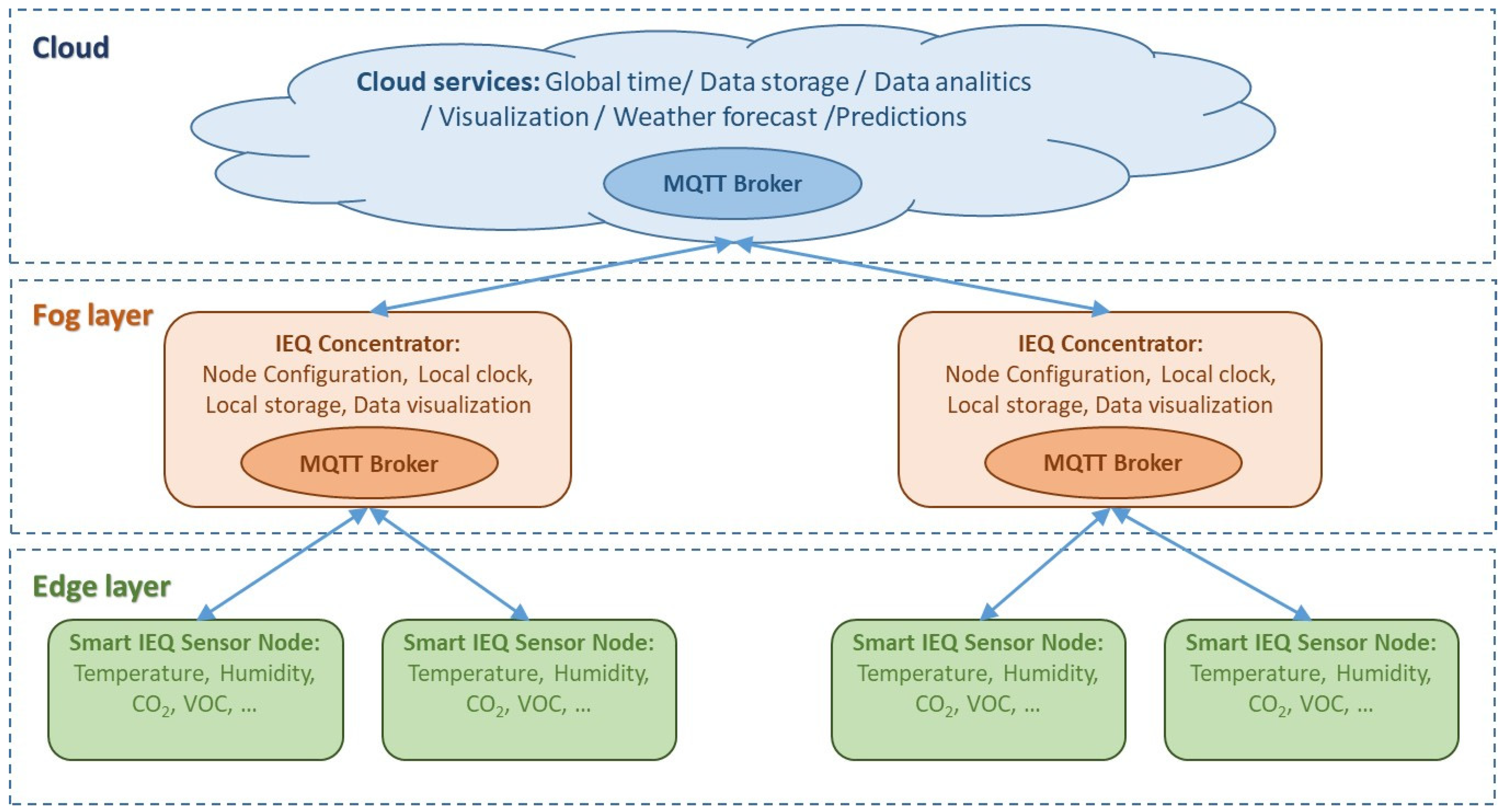
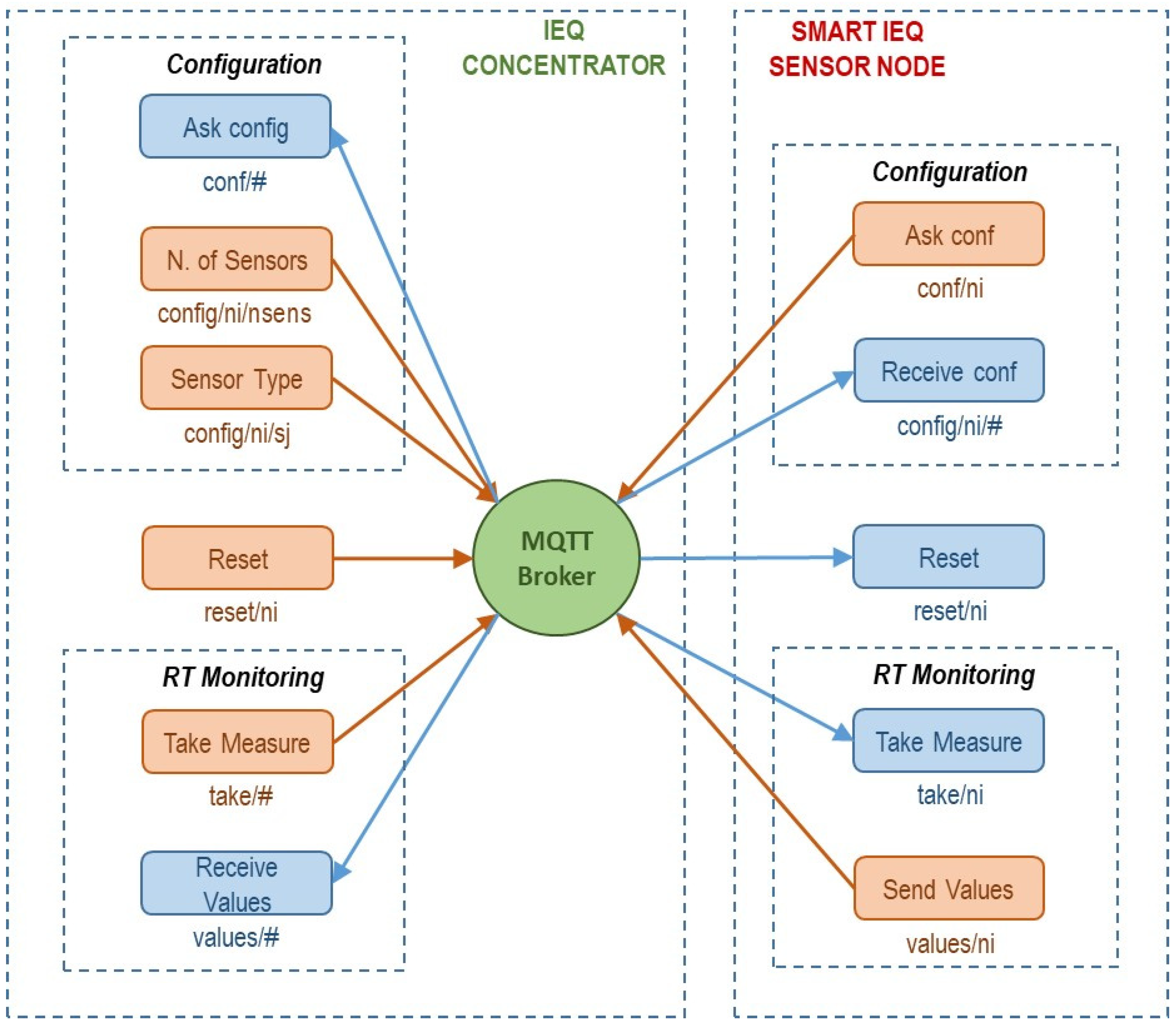
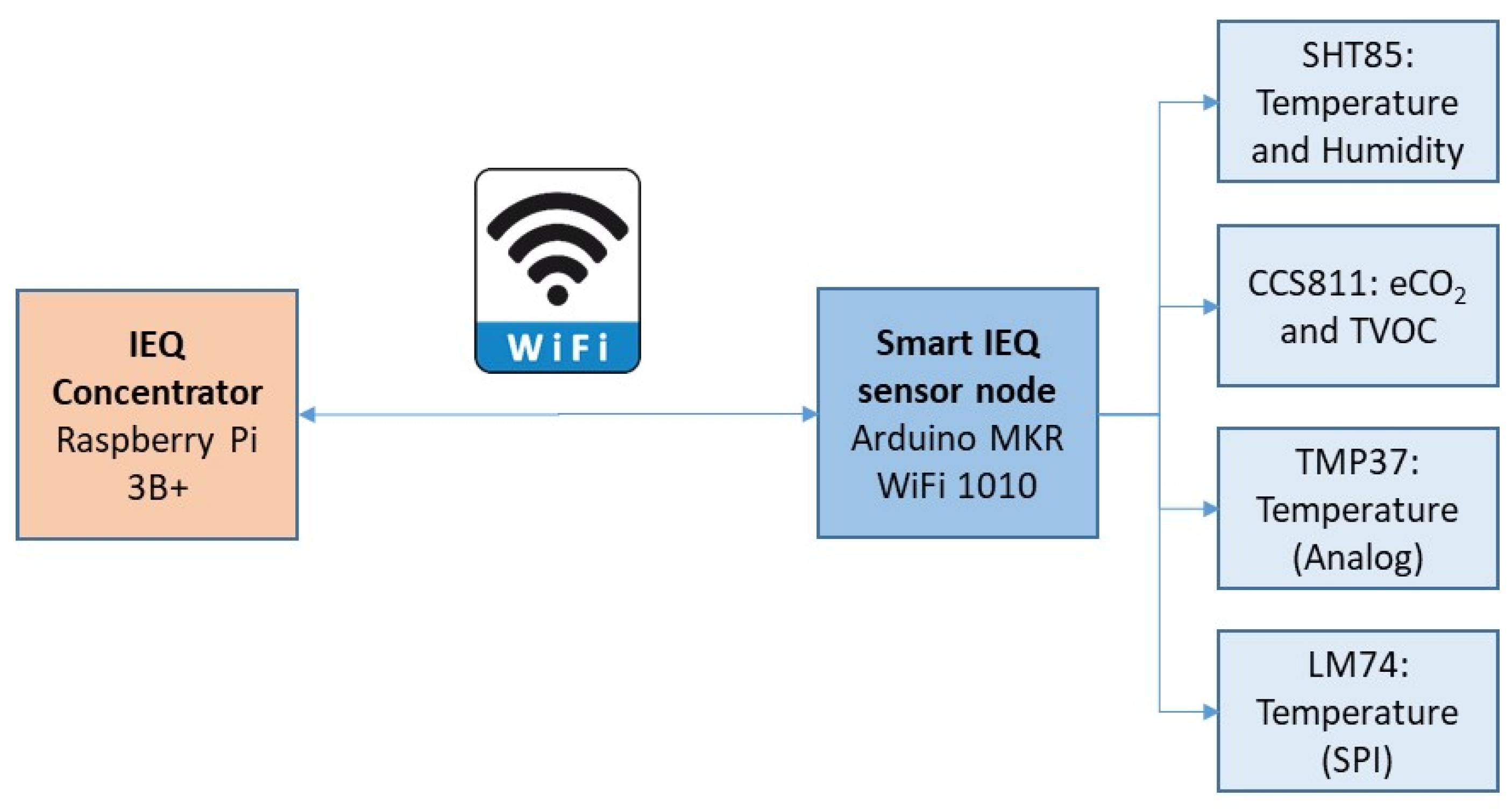
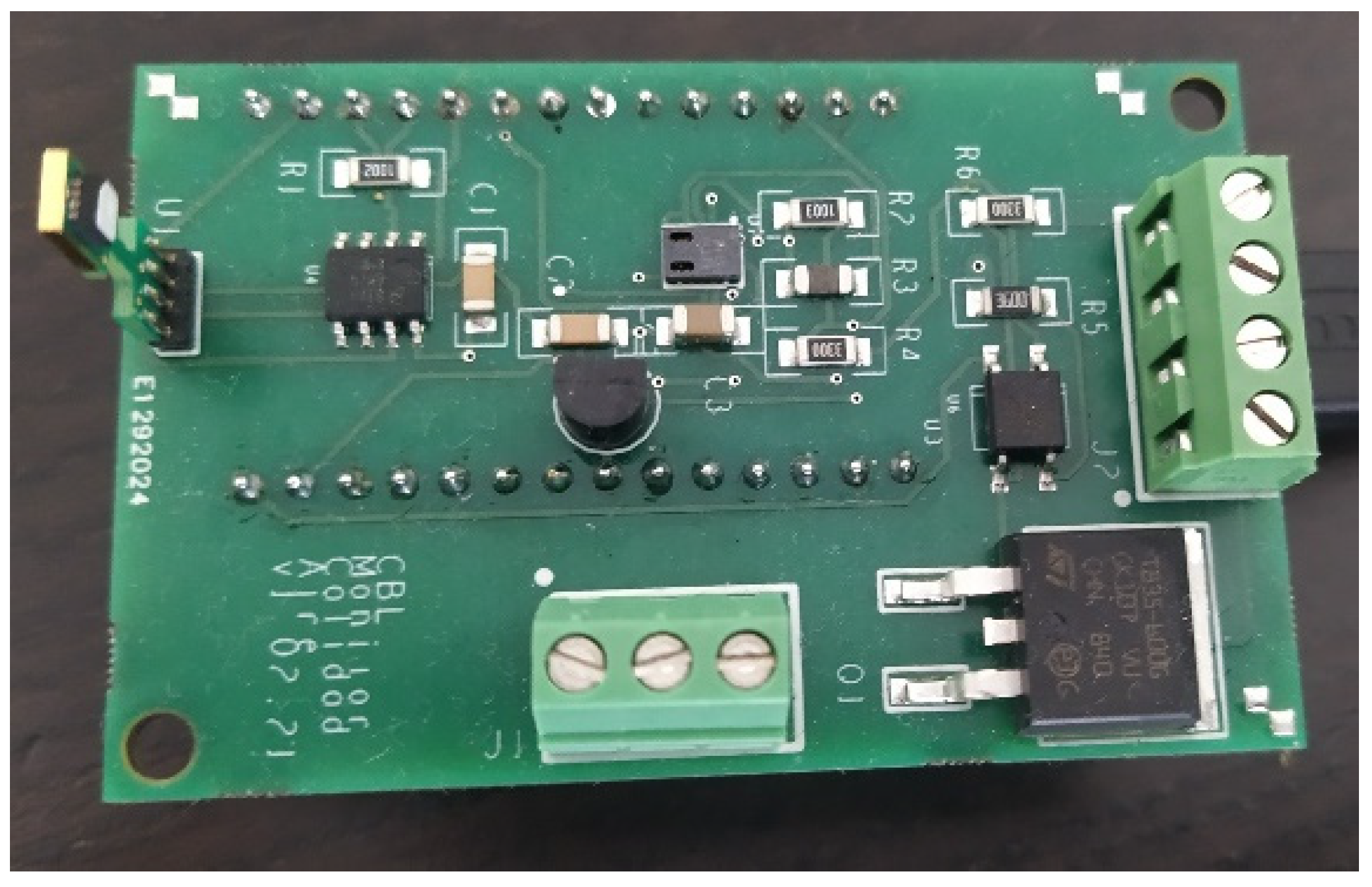
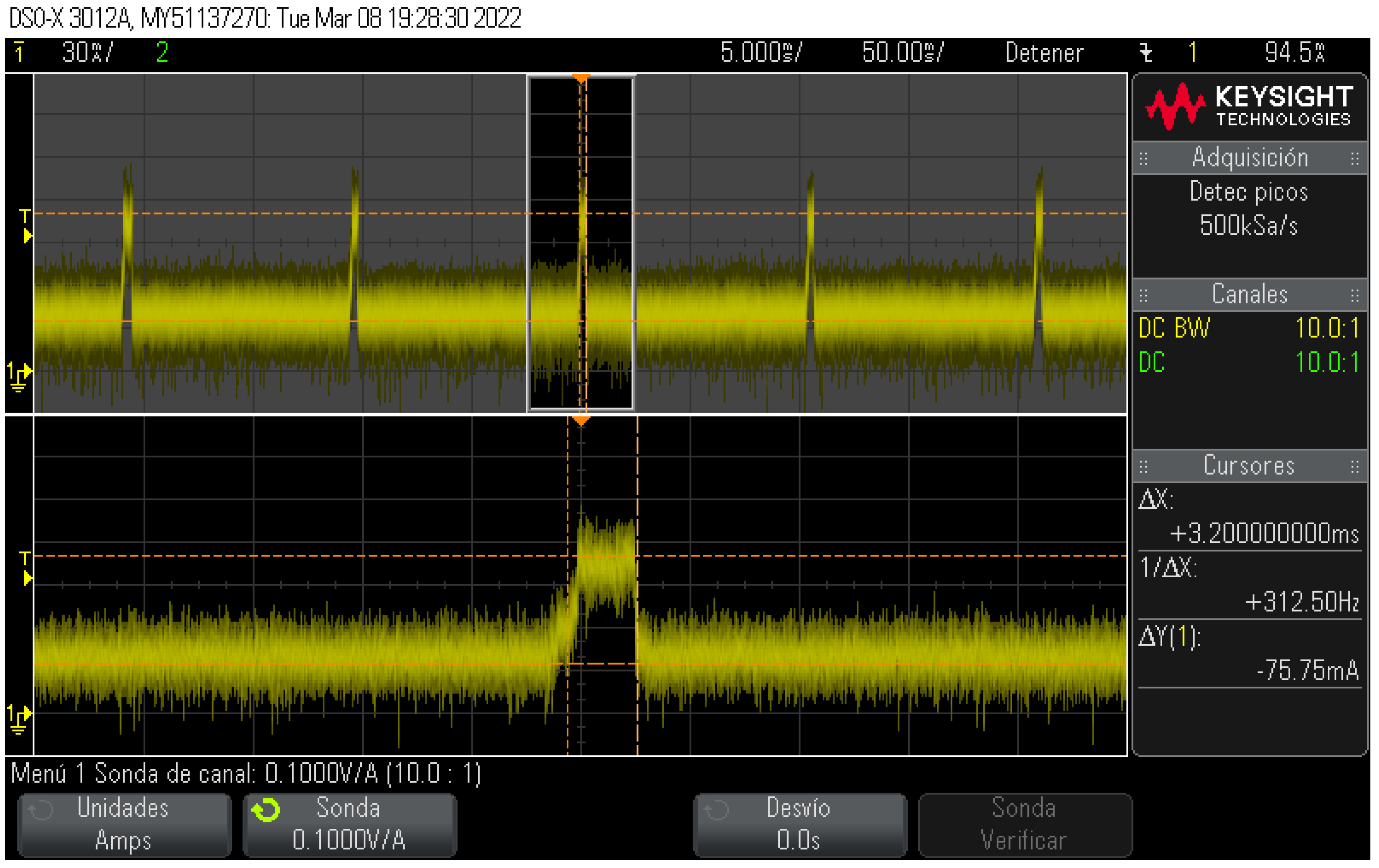


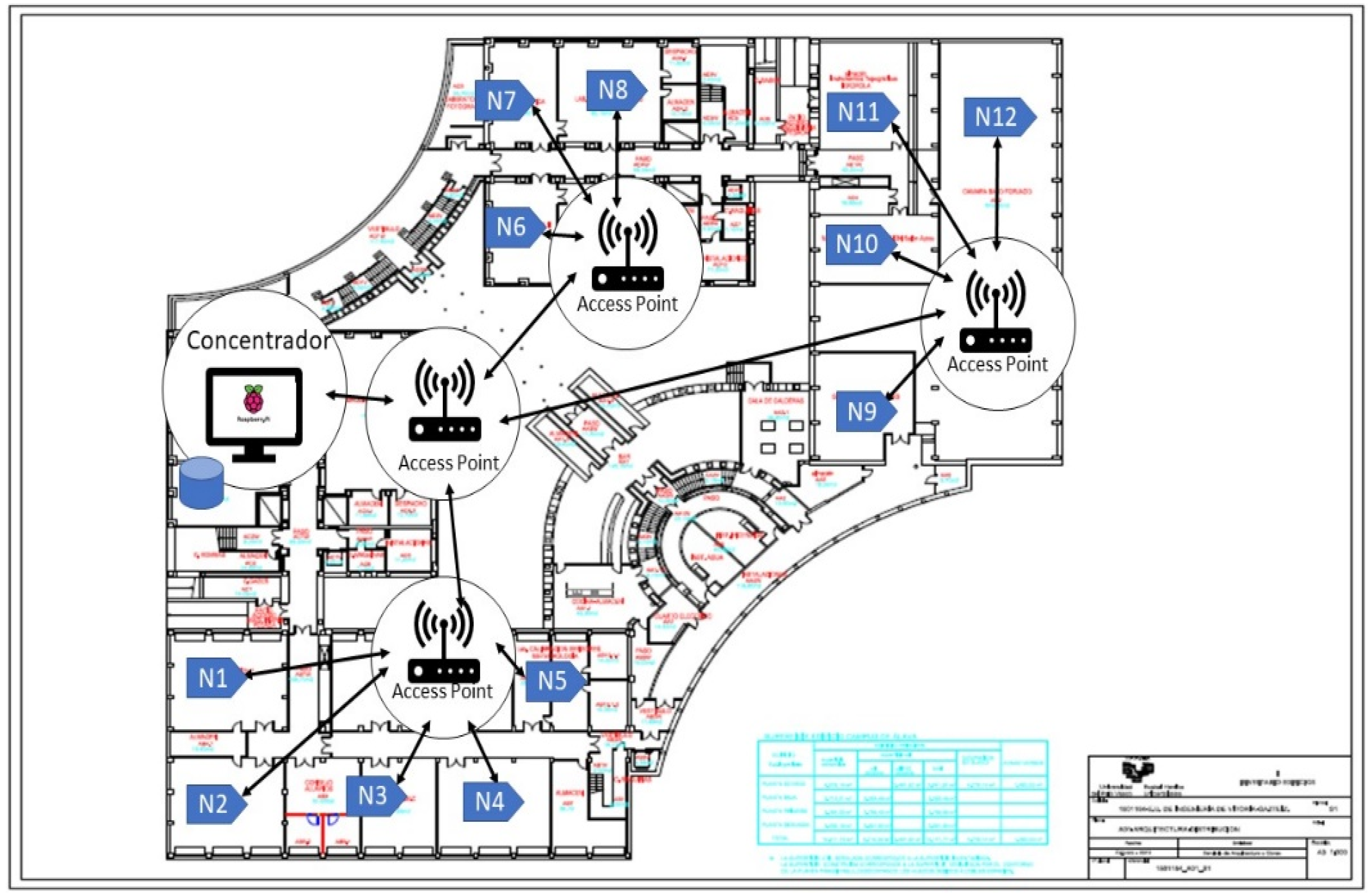

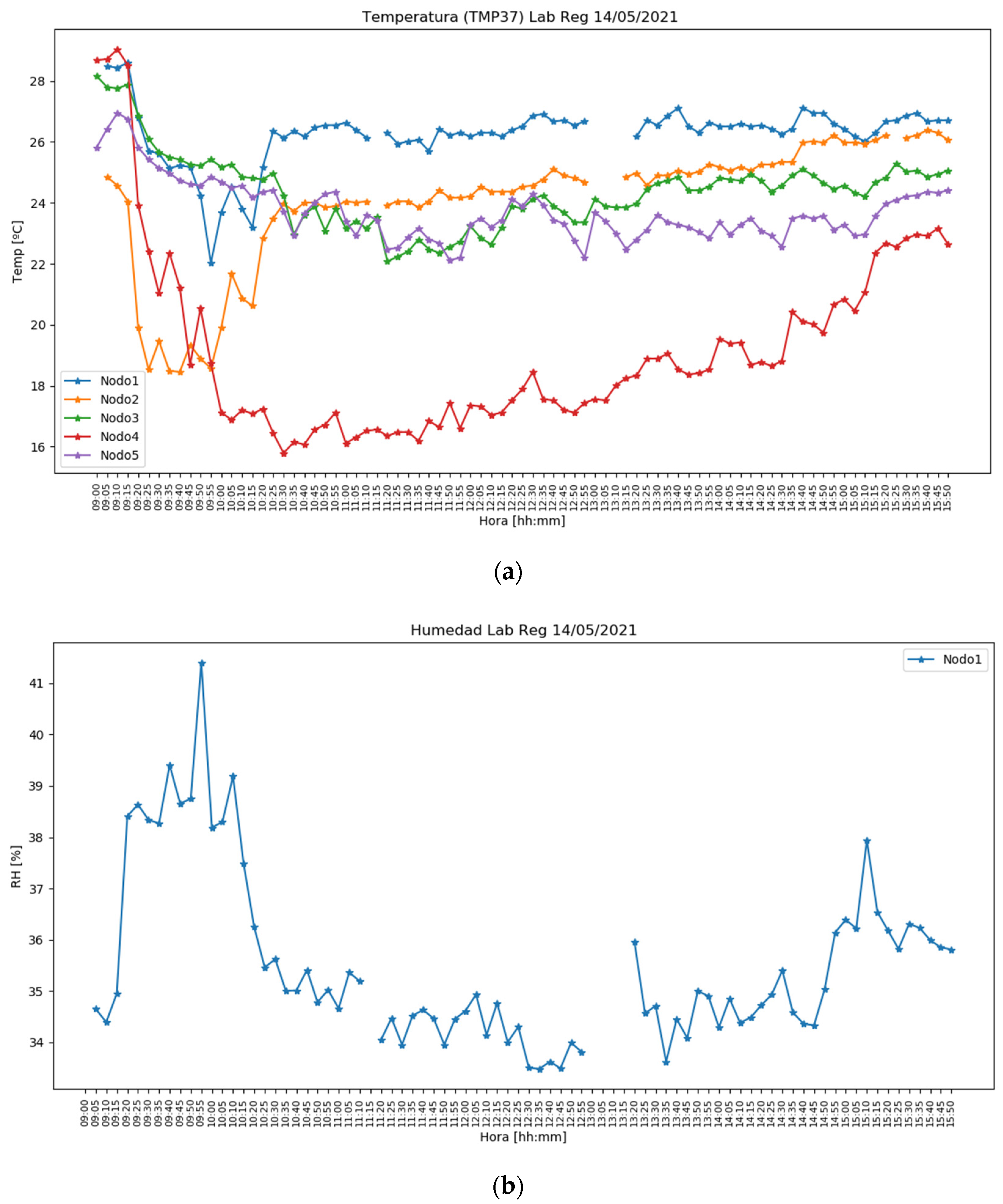
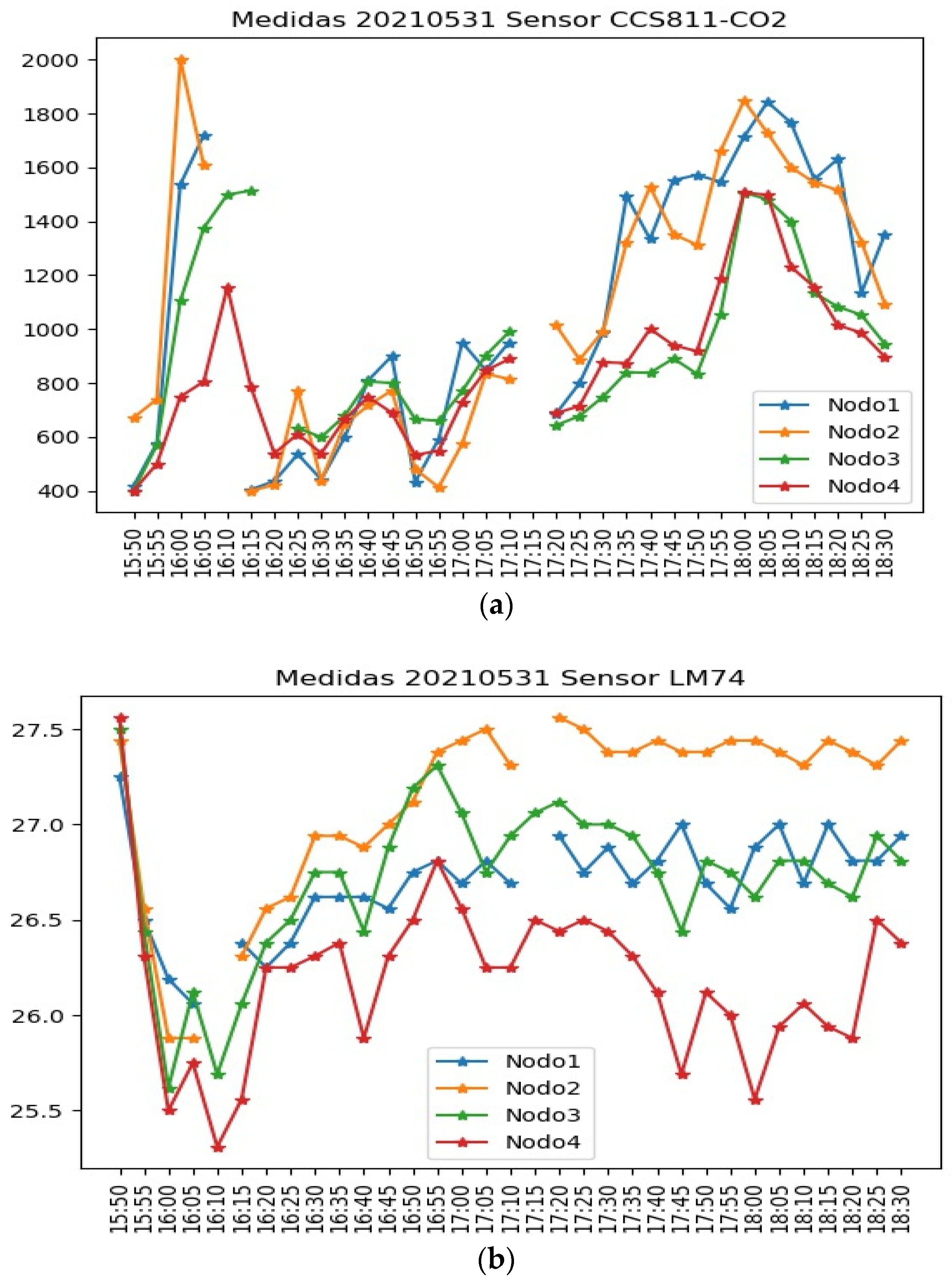
| Variable | Appropriate Values | Standard |
|---|---|---|
| CO2 | Less than 1000 ppm | ASHRAE |
| VOC | Less than 250 ppb | RESET Air |
| Temperature (1.2 m) | Between 23.3 and 27.8 °C | ASHRAE |
| Relative humidity | Less than 65% | ASHRAE |
| TCP/IP Layers | IoT Protocols |
|---|---|
| Application | MQTT |
| Transport | TCP |
| Internet | IPv4 |
| Data Link | IEEE802.11 (WiFi) IEEE802.1Q (VLAN) |
| Sensor | Parameter(s) | A/D | Vendor | Link |
|---|---|---|---|---|
| TMP37 | Temperature | Analog | Analog Devices | [64] |
| LM74 | Temperature | Digital (SPI) | Texas Instruments | [65] |
| SHT85 | Temperature and humidity | Digital (I2C) | Sensirion | [66] |
| CCS811 | eCO2 and TVOC | Digital (I2C) | AMS | [67] |
| Component | Unit Cost (€) |
|---|---|
| IEC Concentrator | |
| Raspberry Pi 3B+ | 30 |
| Raspberry Pi Case | 7 |
| SD Card 32 GB | 13 |
| RPi Power adapter | 10 |
| TOTAL cost for IEC Concentrator | 60 |
| Smart IEC sensor nodes | |
| Arduino MKR WiFi 1010 | 30 |
| Battery 10,000 mAh | 15 |
| PCB and component assembly (including TMP37, LM74 and CSS811 sensors) | 90 |
| TOTAL cost for basic Smart IEC sensor node | 135 |
| Sensors | |
| TMP37 (Temperature) | 1 |
| LM74 (Temperature) | 2 |
| CSS811 (CO2 and VTOC) | 10 |
| SHT85 (Temperature and relative humidity) | 25 |
| Operation State | Current [mA] |
|---|---|
| WiFi transmission | 110 |
| Run mode, no transmission | 42 |
| Deep sleep mode | 30 |
Publisher’s Note: MDPI stays neutral with regard to jurisdictional claims in published maps and institutional affiliations. |
© 2022 by the authors. Licensee MDPI, Basel, Switzerland. This article is an open access article distributed under the terms and conditions of the Creative Commons Attribution (CC BY) license (https://creativecommons.org/licenses/by/4.0/).
Share and Cite
Calvo, I.; Espin, A.; Gil-García, J.M.; Fernández Bustamante, P.; Barambones, O.; Apiñaniz, E. Scalable IoT Architecture for Monitoring IEQ Conditions in Public and Private Buildings. Energies 2022, 15, 2270. https://doi.org/10.3390/en15062270
Calvo I, Espin A, Gil-García JM, Fernández Bustamante P, Barambones O, Apiñaniz E. Scalable IoT Architecture for Monitoring IEQ Conditions in Public and Private Buildings. Energies. 2022; 15(6):2270. https://doi.org/10.3390/en15062270
Chicago/Turabian StyleCalvo, Isidro, Aitana Espin, Jose Miguel Gil-García, Pablo Fernández Bustamante, Oscar Barambones, and Estibaliz Apiñaniz. 2022. "Scalable IoT Architecture for Monitoring IEQ Conditions in Public and Private Buildings" Energies 15, no. 6: 2270. https://doi.org/10.3390/en15062270
APA StyleCalvo, I., Espin, A., Gil-García, J. M., Fernández Bustamante, P., Barambones, O., & Apiñaniz, E. (2022). Scalable IoT Architecture for Monitoring IEQ Conditions in Public and Private Buildings. Energies, 15(6), 2270. https://doi.org/10.3390/en15062270







